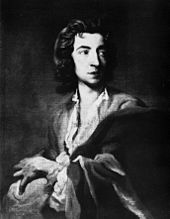Paul Egell
Paul Johann Egell (born April 9, 1691 in Waibstadt ; † January 10, 1752 in Mannheim ) was a German sculptor and plasterer .
Life
Paul Egell comes from an immigrant family from Switzerland . Egell's grandfather came to the Electoral Palatinate around the 1650s because the Elector, who had become Catholic, wanted to rebuild his territory that had been destroyed in the Thirty Years' War . Due to his Catholic origins, he settled in Waibstadt, a Catholic enclave in the otherwise Protestant Electoral Palatinate.
Paul Egell's grandmother and other relatives and family members were accepted into the Rosary Brotherhood . The brotherhood had a chapel in Waibstadt . The membership of Engell's grandmother shows the deep piety of the family. The piety is shown, among other things, in Egel's broken, Marierist formal language in carvings and depictions of affect.
After years of apprenticeship with Permoser in Dresden , Paul Egell was appointed court sculptor in Mannheim by Elector Carl Philipp in 1721 . He is considered one of the finest masters of the early Rococo . Ignaz Günther was his most important student until 1752. Peter Anton von Verschaffelt was appointed as his successor.
Of his works can still be seen:
- So-called. Playing nymph in the nymph bath in the Zwinger (Dresden)
- Stucco reliefs in Mannheim Castle (masks on the castle arcades, gable reliefs on the castle church).
- Gable reliefs on the Jesuit church and design of the silver Madonna there and the organ prospect.
- Wooden and ivory crucifix (around 1725) (exhibited in the Diocesan Museum Mainz).
- Kalvarienberg (exhibited in the Diocesan Museum Mainz).
In 1734/1735 Egell worked on the building of the Palais Thurn und Taxis in Frankfurt am Main on behalf of the Postmaster General and Prince Anselm Franz von Thurn und Taxis . The baroque city palace in 1944 in the Second World War destroyed so that except for some of the stucco and sculptures Egells today spoils only those parts are received, the end of the 19th century Regensburg in the local residence of the Princes of Thurn and Taxis had been transferred .
Shortly before his death, he had completed the design for the Chinese pavilion in Oggersheim . His son Augustin Egell took over the execution .
literature
- Roswitha Beyer: Egell, Paul. In: New German Biography (NDB). Volume 4, Duncker & Humblot, Berlin 1959, ISBN 3-428-00185-0 , p. 322 f. ( Digitized version ).
Web links
- Literature by and about Paul Egell in the catalog of the German National Library
Individual evidence
- ↑ 20,000 names and 1,000 pages await publication. ( Memento from January 7, 2013 in the Internet Archive ) In: Rhein-Neckar-Zeitung . April 23, 2008, p. 5 (PDF; 109 kB).
- ↑ Dr. Stefanie Leibetseder: "Schmuck der Kurpfalz": New source on the origin and genealogy of Johann Paul Egell . Ed .: KUNSTchronik. 67 year, issue 5. Munich 2014, p. 227-230 .
- ↑ schloss-mannheim.de ( Memento of the original from October 10, 2009 in the Internet Archive ) Info: The archive link was inserted automatically and has not yet been checked. Please check the original and archive link according to the instructions and then remove this notice.
| personal data | |
|---|---|
| SURNAME | Egell, Paul |
| ALTERNATIVE NAMES | Egell, Johann Paul |
| BRIEF DESCRIPTION | German sculptor and plasterer |
| DATE OF BIRTH | April 9, 1691 |
| PLACE OF BIRTH | Waibstadt |
| DATE OF DEATH | January 10, 1752 |
| Place of death | Mannheim |

